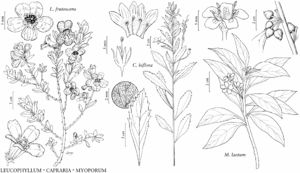Leucophyllum frutescens
Contr. Gray Herb. 70: 89. 1924.
Shrubs erect, not intricately branched, rounded, 5–20 (–30) dm, not appearing thorny. Young stems densely canescent-tomentose, hairs conic to cylindric, dendritic, uneven in height. Leaves alternate, rarely opposite; petiole 1–2 mm; blade obovate to oblong-obovate or obovate-orbiculate, 10–25 (–35) mm, base cuneate, midvein and major lateral-veins raised abaxially, abaxial surface silvery gray, adaxial more greenish, hairs conic to cylindric, dendritic, uneven in height. Flowers: calyx lobes oblong-lanceolate, 3–5 mm; corolla rose lavender to light violet, pink, and rose-pink, rarely white, campanulate, 18–26 mm, tube not notably narrowed. 2n = 34.
Phenology: Flowering (Mar–)May–Sep(–Oct).
Habitat: Rocky and gravelly hillsides, talus, arroyos, ridges, flats, roadcuts, clay dunes, scrub, chaparral, thorn scrub, riparian communities.
Elevation: 10–1200 m.
Distribution
Tex., Mexico (Coahuila), Mexico (Nuevo León), Mexico (Tamaulipas)
Discussion
Leucophyllum frutescens is widely cultivated; horticultural varieties differ in habit, vestiture, and corolla color. The plants are cold hardy and can withstand moderate frosts. As in most or all Leucophyllum species, plants usually flower in response to rain.
In Texas, Leucophyllum frutescens is known from much of the southwestern half of the state.
Selected References
None.
Lower Taxa
"dm" is not declared as a valid unit of measurement for this property.
